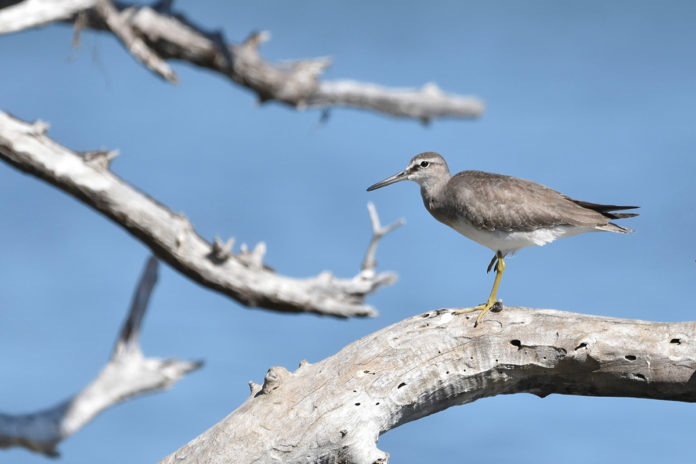I’ve done stupider things, but driving north on U.S. 1 on Fantasy Fest Friday to chase a bird, when I knew I was just going to have to come back down in all that traffic, was at least in my top 50 – for the third decade of the new millennium, anyway.
It was worrisome how thick the traffic was just on upper Sugarloaf before noon, and I knew it would only get worse.
For a while, with the cancellations of the parades, marches and bike rides, it seemed like Fantasy Fest 2021 would be recorded in history with an asterisk next to it. But I was downtown the night before, taking pictures, and it was full-on crazy, as crowded as I had ever seen, with people improvising whatever fun they could. You had to wonder how many more folks were driving down from Miami to improvise even more fun.
Isak Dinesen once advised aspiring novelists to write every day, without hope and without despair. I’ve taken it on as kind of a mantra for all sorts of non-literary activities – go out and do the thing, or at least try to, but don’t get too emotionally caught up in it. It seemed an especially fine maxim when facing hours of bumper-to-bumper purgatory.
Still, the bird, it tasked me.
The bird had been seen at Harry Harris Park in Tavernier. When first reported, it was listed as a wandering tattler, a shorebird with one of my favorite names because it seemed the entire ornithological community had ganged up to label the species a peripatetic blabbermouth, a homeless narc.
The “tattler” part came from the fact that the species tends to call a lot, though opinions vary as to whether it’s tattling to hunters where all the birds are, or tattling to all the other birds that there are hunters around. The “wandering” part comes from the fact that they do like to roam, though mostly on the West Coast, and never as far as Florida. While it was a great sighting for the Keys, I’d seen a bunch of them in Oregon and California, and it wasn’t enough to overcome my innate anti-chasing inertia.
But then the internet bird ID sleuths got on the case, and started analyzing leg colors, tail feathers and supercilia. They decided it was not, in fact, a wandering tattler, but rather the exponentially more rare gray-tailed tattler, a species that breeds in Siberia, winters in Australia, and occasionally shows up in Alaska. According to eBird, there had been only two other sightings of the species in the lower 48 states – one that hung around Nantucket for three days in 2012, and one that flew over an uninhabited rocky island off the coast of Maine in 2017, and was seen and photographed by one guy, who just happened to be out there doing research.
The Tavernier bird had been seen steadily all week – people had been putting up great photos – but a small front had come through early Friday morning, which was my first chance to go see it, and bad weather will sometimes chase a rare bird off, so I waited to see if it was reported later in the morning.
When it was, I texted my pilot friend Craig to see if he would fly me up, and he pointed out that Tavernier didn’t have an airport. When I suggested he land on the highway, he texted back a lot of mealy-mouthed stuff about safety, legality, fines and getting his license revoked, then suggested I make friends with a helicopter pilot.
So I got in the car. Two-and-a-half-hours and 10 chicken McNuggets later, I was at Harry Harris Park.
There was a baker’s half-dozen other birders standing around, spread out along the gulfside shoreline, which wasn’t a good sign. If the gray-tailed tattler was apparent, everyone would have been bunched up together, looking at the bird. But one of the guys there said they’d seen the bird about 45 minutes before, and it seemed to have a pattern. It worked its way down the shoreline, disappeared farther down out of sight for a while, then came back and started all over again, kind of like a typewriter working itself across the page.
I set up on a rock and began my vigil in a small cove with a wrecked sailboat with “Ship of Fools” painted on the transom.
There was quite a bit to see. Boats were coming in and out of the boat ramp. A Cooper’s hawk shot up and into the top of a buttonwood and gave me the stink eye. Ruddy turnstones disappeared in and out of the rocks. An influencer having her moment walked out onto the pier in a long, flowing dress as two people followed her around with cameras. Osprey made their complaints. A great white heron slow-stepped through the shallows.
Occasionally I would get up from my rock and walk down to the end of the park and back, stopping to talk to the other birders, asking if they’d had any luck, but knowing by their dispositions before we even spoke, that they had not.
After three hours I realized it was time to head back, and I was fighting off the feeling that karma had gone all Lucy Van Pelt on me again, making me commit to actually wanting something, before pulling away the football of me actually getting it. But that’s a bad way to think.
I wasn’t going to have a chance to drive up again for at least another week, but it was possible the bird could be there. It was possible the bird would stay all winter. Weird stuff happens in the Keys. It’s why we live here.
I got into the car and drove back to the highway, merging with the line of other cars, without hope and without despair. And honestly, the traffic wasn’t all that bad.



























